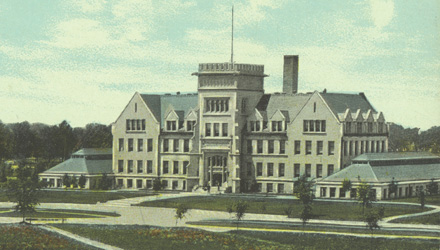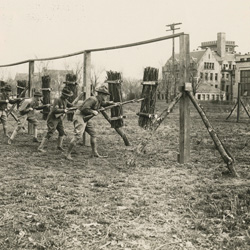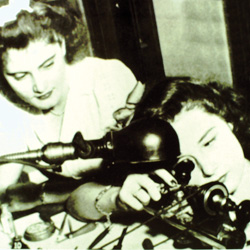Currently undergoing major renovations as part of the Campaign for a Bradley Renaissance, Bradley University’s Westlake Hall got its start as a school of horology—the art of making timepieces.
The clock tower in Bradley University’s historic Westlake Hall recently received a facelift as part of a major renovation and expansion of the university’s second oldest building, expected to be complete this summer. This new clock face, which bears Roman numerals similar to the original design, is a fitting symbol for the beginnings of the institution…
The idea for a watchmaking school was first conceived by J.R. Parsons of Indiana, who felt that what he had spent most of his life learning to do could be taught in substantially less time at a proper school. An increased demand for skilled workers in his trade also fueled the idea. After reading a letter in a journal from a young man asking if there was a school where one could learn the watch trade, Parsons decided to establish such a school. As a result, in 1886, the Parsons Horological Institute—the first watchmaking school in the country—opened in La Porte, Indiana.
A Peoria Transplant
The school was a major success, but after six years, it was beginning to outgrow its accommodations. By this time, philanthropist Lydia Moss Bradley of Peoria had become interested in the school and the idea of assisting young men and women who desired to learn the trade. Bradley offered a larger building with all the necessary equipment, and in 1892, she bought and moved the Indiana-based school—with its 100 students, full staff of teachers and all—to Peoria. This was just one of the many projects into which she poured her energies.
After briefly being housed inside a building of the Peoria Watch Company, a fire in 1896 led Bradley to incorporate the horological school into Bradley Polytechnic Institute, which she endowed in 1897. The school then became known as the Horological Department of Bradley Polytechnic Institute, and a new, large building made of Bedford stone was erected specifically to accommodate its growth. Known as Horology Hall, it was designed by Henry Ives Cobb, architect for the University of Chicago and several buildings at the Columbian Exposition. It was the first building in the United States to be constructed solely for use as a school of horology.
 A Cutting-Edge Reputation
A Cutting-Edge Reputation
Peoria soon gained an international reputation as students from all over the United States and many foreign countries enrolled at Bradley to learn watchmaking. The university also attracted women in large numbers, as the school, progressive for its time, admitted both men and women, in spite of a turn-of-the-century debate over whether “the intellectual capacities of women were not at least as unlike those of men as their bodily capacities are,” as Charles W. Eliot, president of Harvard College, declared in 1899.
The school’s year-round instruction allowed students flexibility. One could enter at any time and move at his or her own pace, remaining until the work was completed. In addition to 12 months of watchmaking, instruction also included “three months of jewelry and three months of engraving,” The Scout reported in 1961.
Along with a thorough curriculum, the school boasted modern, well-stocked equipment and exceptional facilities. In 1906, Bradley’s Polyscope yearbook described the building as having two stories and a basement, with the ground floor consisting of a reception room, offices and the Primary Department, where students were taught to make small tools, such as drills, jewel gravers and screw taps. Here, students also learned the use of grinding materials, tempering, coloring and polishing here—the foundation of practical watch work. The basement had a large room to accommodate the Jewelry Department, where students were taught to work with gold and silver, soldering, repair work and setting stones. The Clock Department, electrical room, gold melting room and mechanical room were also on this floor, with a large room on the second floor devoted to the Engraving and Finishing Department.
Heated by steam and lit by electricity, the building’s rooms were large and well-ventilated. Each worker’s bench was equipped with both gas and electric lights, and each department had a large sink supplied with running water. A six-horsepower Eagle electric motor and four-horsepower gas engine provided power for the heavier works—large lathes, grindstones and emery wheels.
 War Time
War Time
The institution played an active role in technical training on behalf of the government during the First World War. On April 10, 1918, the Committee on Education and Special Training, representing the War Department, established Camp Bradley at Bradley Polytechnic Institute for the technical training of soldiers. The Army School of Mechanics was given near-exclusive use of Horology Hall to instruct soldiers in lens grinding, gunsmithing and the repair of fine instruments chiefly for use by the Air Force—mechanisms that recorded the height, speed, declination and inclination of airplanes.
Attendance skyrocketed after the two world wars and the Korean War, as the School of Horology trained eager ex-servicemen in the trade, courtesy of the G.I. Bill. In fact, according to The Scout, the school “gained a national reputation for training the handicapped” in particular, with “veterans…flock[ing] to take advantage of the free instruction.”
“After World War II, the facilities and staff were expanded to accommodate more than 400 students who enrolled,” The Scout continues. “And during that 10-year post-war period, the school had to turn away 17,000 students!”
 A Clock for the Ages
A Clock for the Ages
Built in 1898, Parsons’ original crafted clock was first housed in the tower of Horology Hall. But Grant Hood, a faculty member during the early 1900s, had a difficult time with the clock, which had not been properly constructed. Therefore, around 1904, plans for a new clock were adopted. Shop students made the weights, framework and heavy casings, and horology students completed the delicate work. The clock was wound manually, twice a week, for 40 years. In the 1950s, an electric winding mechanism was added to the clock so it could run for several months at a time without attention. In the ‘60s, it received another new face and was converted to run fully on electricity.
In 1946, Horology Hall was renamed Westlake Hall after Allen T. Westlake, the founding dean of the Horology Department, who served from its beginning until his death in 1931. Westlake was a beloved instructor, called “Papa Horology” by his students. He was one of the pioneer instructors in horology and attended the first conference that sparked the creation of the Horological Institute of America in Washington, D.C.
Despite its earlier glory days, attendance dwindled, and in 1961, the horology school closed its doors. The program would be transplanted once more, as Gem City Business College in Quincy, Illinois, purchased the remainder of its assets. In the end, more than 11,000 craftsmen had graduated from Bradley’s School of Horology.
So, the next time you look up at Bradley’s splendid new clock that towers over the campus, think of Lydia Moss Bradley and her quest for providing valuable educational opportunities for young men and women. Or, simply marvel at the craftsmanship itself—the clock’s four five-and-a-half foot glass panels weigh about 300 pounds each, according to The Scout—and with the help of a few hand exchanges and new faces, it still ticks, 114 years and counting. iBi
Ashlee Brown graduated from Eureka College in 2008 with a bachelor’s degree in history and received her master’s degree in history from the University of Illinois at Springfield in 2010. She volunteers for the Eureka College Archives and was an intern at the Peoria Historical Society.


